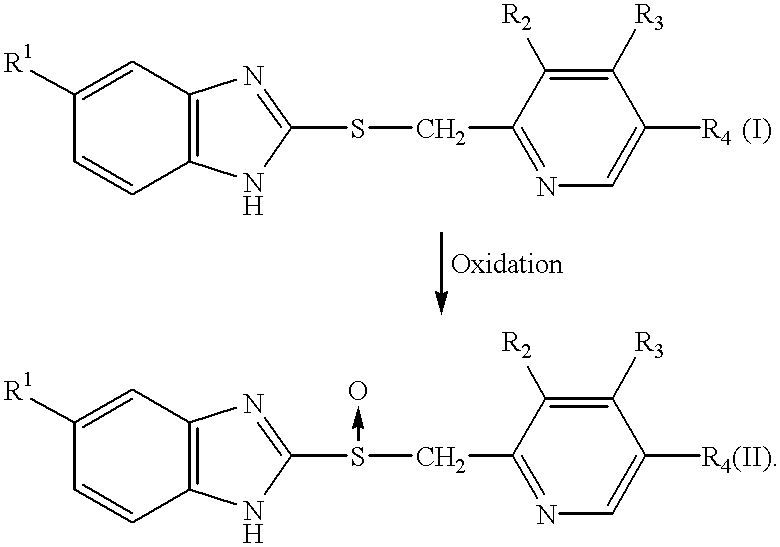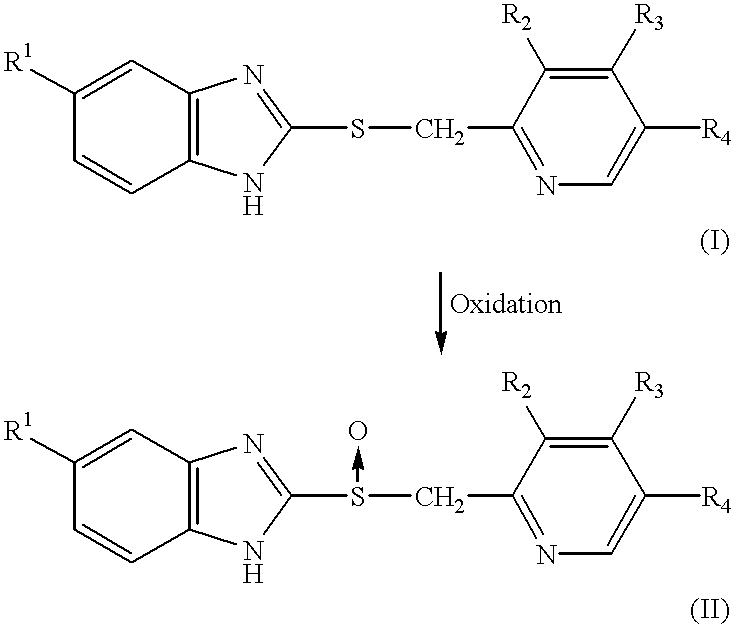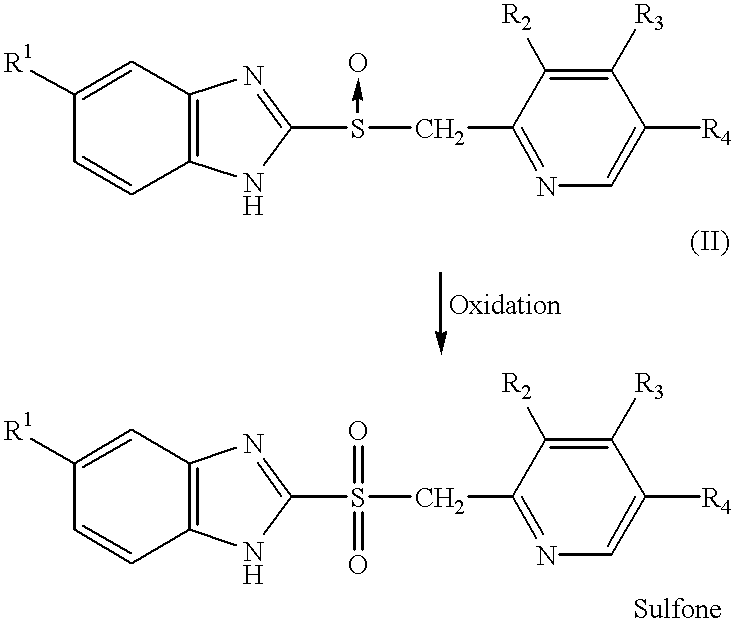Process for the preparation of pyridine derivatives
a technology of pyridine and derivatives, which is applied in the direction of organic compounds/hydrides/coordination complex catalysts, organic chemistry, physical/chemical process catalysts, etc., can solve the problem that halogenated hydrocarbon solvents cannot be used industrially, the yield of objective sulfoxide is reduced, and the separation and purification is difficul
- Summary
- Abstract
- Description
- Claims
- Application Information
AI Technical Summary
Problems solved by technology
Method used
Image
Examples
example 1
Synthesis of 2-{[4-(3-methoxypropoxy)-3-methylpridin-2-yl]methylsufinyl}-1H-benzimidazole (Rabeprazole free base)
##STR7##
Sodium perborate 4H.sub.2 O (tetrahydrate) (3.06 g, 18.9 mmol, 97%) was suspended in water (8 ml), and then, acetic anhydride (1.84 ml, 18.9 mmol, 95%) was added dropwise thereto while the bulk temperature of the mixture was kept at 20.degree. C. The resulting mixture was then stirred for about 5 min, to prepare a homogenous solution. Methanol (8 ml) was further added thereto. The resulting solution was added dropwise into a solution (55 ml) of 2-{[4-(2-methoxypropoxy)-3-methylpyridin-2-yl]methylthio}-1H-benzimidazole (referred to as Compound I hereinafter; 5.0 g, 14.6 mmol) in toluene / methanol (10:1) at -20.degree. C. over about 30 min, and the resulting mixture was continued stirring at the same temperature. After about 2 hr, the completion of the reaction was confirmed by HPLC. 10 ml of an aqueous 0.1 wt % sodium hydrosulfite solution was added to the resulting...
example 2
Synthesis of 2-{[4-(3-methoxypropoxy)-3-methylpyridin-2-yl]]methylsulfinyl}-1H-benzimidazole (Rabeprazole free base)
Sodium perborate.4H.sub.2 O (2.12 g, 13.8 mmol) was dissolved in 10 ml of water / methanol (1:1) solution containing of acetic anhydride (1.28 ml, 13.8 mmol). The resulting solution was added dropwise into 66 ml of a solution of the Compound I (3.0 g, 8.73 mmol) in toluene / methanol (10:1) at -5.degree. C. over about 40 min, and then the resulting mixture was stirred as it was at the same temperature. The reaction was followed by HPLC. 1.5 hr after the dropwise addition, a 0.1 wt % aqueous solution of sodium hydrosulfite solution (10 ml) was added thereto, and the resulting mixture was stirred as it was at the same temperature for 10 min. The reductive activity of the solution was confirmed with potassium iodide starch paper followed by adding a 2 M aqueous solution of sodium hydroxide (8.6 ml) to adjust the solution to pH 8 and adding 40 ml of water. After separating the...
example 3
Synthesis of 2-{[4-(3-methoxypropoxy)-3-methylpyridin-2-yl]methylsulfinyl}-1H-benzimidazole (Rabeprazole free base)
Sodium perborate 4H.sub.2 O (2.68 g, 17.42 mmol) was dissolved in a solution (10 ml) of water / methanol (1:1) containing acetic anhydride (1.60 ml, 17.46 mmol). The resulting solution was added dropwise into a solution (66 ml) of the Compound I (3.0 g, 8.73 mmol) in toluene / methanol (10:1) at -5.degree. C. over 24 min and the resulting mixture was continued stirring as it was at the same temperature. After about 30 min, the completion of the reaction was confirmed by HPLC. Subsequently, the same procedures as in the previous Example were conducted to give the title compound (2.45 g, yield; 78.2%) as a white solid.
PUM
| Property | Measurement | Unit |
|---|---|---|
| temperature | aaaaa | aaaaa |
| temperature | aaaaa | aaaaa |
| temperature | aaaaa | aaaaa |
Abstract
Description
Claims
Application Information
 Login to View More
Login to View More - R&D
- Intellectual Property
- Life Sciences
- Materials
- Tech Scout
- Unparalleled Data Quality
- Higher Quality Content
- 60% Fewer Hallucinations
Browse by: Latest US Patents, China's latest patents, Technical Efficacy Thesaurus, Application Domain, Technology Topic, Popular Technical Reports.
© 2025 PatSnap. All rights reserved.Legal|Privacy policy|Modern Slavery Act Transparency Statement|Sitemap|About US| Contact US: help@patsnap.com



